
Opened: 80 AD
Construction Began: 71 AD
Capacity: 50,000
Original Construction Cost: Unknown
Starting Emperor: Vespasian
Starting Emperor: Titus
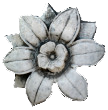

 The Year of the Four Emperors was a tumultuous time for Rome. General Vespasian and his son Titus had been trying to put down a major Jewish rebellion. In the Battle of Beth Horon Jewish forces defeated a much larger Syrian Greek army due in part to their surprise attack. Emperor Nero had sent Vespasian to put down the rebellion, and Vespasian's son had joined him later with the 15th legion after Vespasian realized they were in for a major campaign. Vespasian and Titus had a force of 60,000 men at their command as they prepared to sweep across Galilee and retake Jerusalem. The campaign was halted, however, when news came of the death of Emperor Nero back in Rome.
The Year of the Four Emperors was a tumultuous time for Rome. General Vespasian and his son Titus had been trying to put down a major Jewish rebellion. In the Battle of Beth Horon Jewish forces defeated a much larger Syrian Greek army due in part to their surprise attack. Emperor Nero had sent Vespasian to put down the rebellion, and Vespasian's son had joined him later with the 15th legion after Vespasian realized they were in for a major campaign. Vespasian and Titus had a force of 60,000 men at their command as they prepared to sweep across Galilee and retake Jerusalem. The campaign was halted, however, when news came of the death of Emperor Nero back in Rome.
The new emperor, Galba, had been governor of Hispania, or what today is the Iberian Peninsula. General Vespasian halted the Jewish campaign while he awaited further orders, and he sent his son Titus to meet with the new emperor. Before Titus even reached Italy, however, he learned that Galba had been murdered by the governor of Lusitania, Otho. Lusitania was a small province on the Iberian Peninsula that used to be a part of Hispania and Otho had been sent there by Emperor Nero when Nero began having an affair with Otho's wife. There Otho had collaborated with Galba to overthrow Nero. Galba's forces tried to take control, but, for a time, were confined by Nero's forces in the city of Clunia. The Roman Senate, however, did not approve of Nero's handling of the situation and declared Galba emperor. Nero fled to a suburb of Rome where he committed suicide, thus ending the Julio-Claudian dynasty that had begun with the first Roman emperor Augustus. The Senators, nobility, and the upper-class all welcomed the overthrow of Nero, but the lower-class, slaves, and those who appreciated visiting the arena or theater were disappointed to lose the excesses that Nero lavished on Rome. The soldiers had mixed feeling about the coup because, although they had allegiance to the emperor, they had been paid to help overthrow him.
Emperor Galba was fairly advanced in years, and since he had no children Otho was convinced he would be the next emperor of Rome. In January of 69, however, Otho's delusions of grandeur were thrown a curveball when Galba adopted Lucius Calpurnius Piso Licinianus and it was clear Piso would succeed Galba on the throne. Otho decided to take matters into his own hands and used the little money he had remaining to hire 23 of the emperor's personal bodyguards. Only five days after the adoption of Piso Otho's forces met Galba at the steps of the Capitol where Galba, Piso, and others were murdered by Otho's mercenaries. Since the population was unhappy with Galba and Otho bore a resemblance to Nero he was embraced as emperor, for a time.
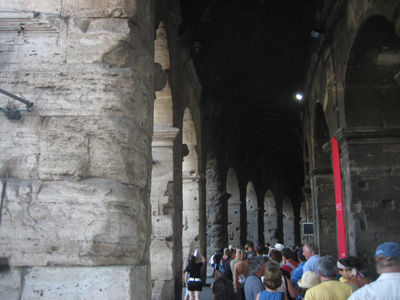 Otho reinstalled many of Nero's officers who had been deposed, set up many of Nero's statues, and announced the intended completion of the Golden House on the grounds that would hold the Colosseum in the near future. Otho even quelled the fears of the upper-class with his liberal tendencies and talk of equitable government. However, trouble would come from outside of Rome where a revolution by the legions in Germania had become dangerous as several Roman legions had declared allegiance to General Vitellius. Vitellius had been appointed by Galba as commander of the Germania armies, and he quickly established a rapport with the troops who refused to renew their allegiance to Galba. By the time Otho took the throne the legions of Vitellius had decided to take the throne for their general and were approaching Italy. Otho did not learn how close the legions were until he took the throne, and when he realized how close they were to Rome he attempted to bribe Vitellius with some of Rome's lands. This didn't work, though, so Otho was forced to prepare for war. The troops of Vitellius were held off for a time, but this changed when the commander of the other half of the Germanic legions, Valens, joined Vitellius. Valens had convinced his legions to support Vitellius and had taken a route through Gaul to recruit more supporters. At the Battle of Bedriacum Otho's more experienced advisors told him to wait for reinforcements from Dalmatia, but Otho, always impatient, went ahead with the attack. The troops he sent were ambushed, and those troops who were not killed joined forces with Vitellius. Although Otho still had a large number of legions at his disposal, and the reinforcements from Dalmatia had arrived, he had considered himself defeated, and killed himself with his own dagger after a reign of only three months.
Otho reinstalled many of Nero's officers who had been deposed, set up many of Nero's statues, and announced the intended completion of the Golden House on the grounds that would hold the Colosseum in the near future. Otho even quelled the fears of the upper-class with his liberal tendencies and talk of equitable government. However, trouble would come from outside of Rome where a revolution by the legions in Germania had become dangerous as several Roman legions had declared allegiance to General Vitellius. Vitellius had been appointed by Galba as commander of the Germania armies, and he quickly established a rapport with the troops who refused to renew their allegiance to Galba. By the time Otho took the throne the legions of Vitellius had decided to take the throne for their general and were approaching Italy. Otho did not learn how close the legions were until he took the throne, and when he realized how close they were to Rome he attempted to bribe Vitellius with some of Rome's lands. This didn't work, though, so Otho was forced to prepare for war. The troops of Vitellius were held off for a time, but this changed when the commander of the other half of the Germanic legions, Valens, joined Vitellius. Valens had convinced his legions to support Vitellius and had taken a route through Gaul to recruit more supporters. At the Battle of Bedriacum Otho's more experienced advisors told him to wait for reinforcements from Dalmatia, but Otho, always impatient, went ahead with the attack. The troops he sent were ambushed, and those troops who were not killed joined forces with Vitellius. Although Otho still had a large number of legions at his disposal, and the reinforcements from Dalmatia had arrived, he had considered himself defeated, and killed himself with his own dagger after a reign of only three months.
News reached the Judean armies of the death of Otho and, possibly fed up with the prospect of yet another unknown emperor, they declared allegiance to General Vespasian as their emperor. Titus, meanwhile, had returned to his father after the murder of Galba as he did not want to be captured in the coming civil war. The civil war left the empire of Rome in chaos. Though the Roman Senate approved Vitellius as emperor he was not widely loved. Riots and massacres joined the normal gladiator shows and extravagant feasts. In addition, Vitellius had disbanded the emperor's body guards and installed his own men. Vespasian was quickly gaining support in the meantime, and his son Titus had negotiated with Mucianus, the powerful governor of Syria, to join forces with his father. Mucianus marched his troops on Rome while Vespasian gathered more support in Alexandria. Vitellius, whose administration was hurt by the controlling Valens, knew that he could not defeat the growing support for Vespasian so he awaited Vespasian's army at Mevania where he intended to resign his position. His body guards, however, refused to allow him to do this and forced him the return to the palace. When Vespasian's troops entered Rome they killed the emperor on the Geronian Stairs and threw his body in the Tiber River. This ended the Year of the Four Emperors and finally provided some stability to the Empire.
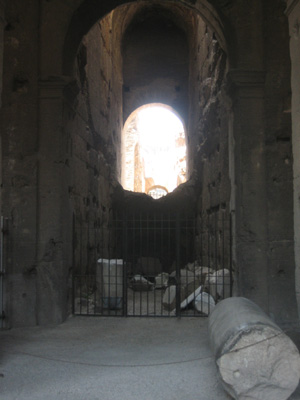 While his father was seizing the throne, Titus had been left to deal with the Jewish rebellion. The Jewish resistance had split into two factions, and Titus used this confusion to begin his assault on Jerusalem. Titus surrounded the city with four legions and began to cut off their supplies by letting pilgrims in to celebrate Passover but not allowing them to leave. The Jews continued to snipe at the Roman legions, however, and nearly captured Titus at one point. After a negotiation for surrender fell through Titus quickly broke through the first and second walls of the city. By the time the third and final wall was breached the Jews were devastated by famine and bitter street fighting broke out. After capturing the Antonia Fortress the Romans began an assault on the Temple of Jerusalem. The Temple was completely destroyed, but it is unclear whether Titus wanted the holy symbol destroyed or if it was an accident. The historian Josephus estimated that over 1 million people, most of them Jewish, were killed in the siege of Jerusalem. Although that number cannot be verified it is known that a large number of Jews were captured and sent to Rome where they would help build Vespasian's Colosseum.
While his father was seizing the throne, Titus had been left to deal with the Jewish rebellion. The Jewish resistance had split into two factions, and Titus used this confusion to begin his assault on Jerusalem. Titus surrounded the city with four legions and began to cut off their supplies by letting pilgrims in to celebrate Passover but not allowing them to leave. The Jews continued to snipe at the Roman legions, however, and nearly captured Titus at one point. After a negotiation for surrender fell through Titus quickly broke through the first and second walls of the city. By the time the third and final wall was breached the Jews were devastated by famine and bitter street fighting broke out. After capturing the Antonia Fortress the Romans began an assault on the Temple of Jerusalem. The Temple was completely destroyed, but it is unclear whether Titus wanted the holy symbol destroyed or if it was an accident. The historian Josephus estimated that over 1 million people, most of them Jewish, were killed in the siege of Jerusalem. Although that number cannot be verified it is known that a large number of Jews were captured and sent to Rome where they would help build Vespasian's Colosseum.
When Titus returned to Rome he was celebrated by his father. After Titus' death the Arch of Titus was erected to celebrate his victory in Jerusalem. The Hebrew Talmad forbids Jews to walk under the Arch, and most Jews followed this law until the creation of the State of Israel. Nowadays many will walk under it only if they are walking away from the center of Rome. Titus, though, refused to accept a wreath of victory from his father when he first return because, in his words, there is "no merit in vanquishing people forsaken by their own God."
After the Year of the Four Emperors Vespasian wanted to restore some order to Rome and hopefully bring some peace to the land, although peace would not come until late in Vespasian's reign. One thing that Vespasian attempted to do was continuing many of the works of the last long-term emperor, Nero. Although many of the people were fed up with Nero at the end of his reign they had begun to reminisce about him as the civil war had left many discontent citizens of Rome. One of the things Vespasian wanted to do was continue the improvements around the area of Nero's Golden House. The area had been devastated by the Great Fire of Rome in 64 AD and Nero built the Golden House as an unconventional palace that took advantage of artificial landscapes instead of being a colossal building of stone and brick. The house was pretty much a place to party as there were nearly 300 rooms with no places to sleep. In the house Nero erected a giant bronze statue of himself that seemed to depict him as the sun god Helios (Sol). When Vespasian took over he had the statue modified so it looked less like Nero and it was renamed Colossus Sol. Just outside of the Golden House was a giant artificial lake surrounded by numerous gardens and supplied with water by an aqueduct. This was to be the area than Vespasian would choose to build a new arena.
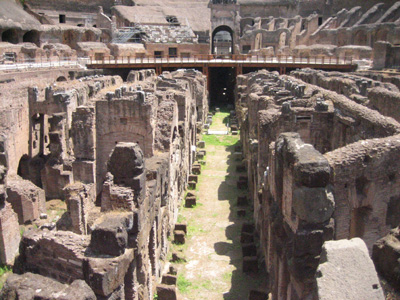 Vespasian tore down much of the Golden House, filled in the lake, and began the construction of the Flavian Amphitheater. Money for this project was not taken from public funds, but was actually taken from Vespasian's share of the treasure stolen from Jerusalem. The Jews had another part in the building of the amphitheater as nearly 20,000 slaves from the rebellion had been brought to Rome to build it. The Flavian Amphitheater was the first arena to be built in the center of Rome. Previous amphitheaters were built on the outskirts of the city. When Vespasian died in 79 the Flavian Amphitheater had been completed up to the third floor. When his son Titus took over the amphitheater was completed and inaugurated in 80 AD with a series of inaugural games.
Vespasian tore down much of the Golden House, filled in the lake, and began the construction of the Flavian Amphitheater. Money for this project was not taken from public funds, but was actually taken from Vespasian's share of the treasure stolen from Jerusalem. The Jews had another part in the building of the amphitheater as nearly 20,000 slaves from the rebellion had been brought to Rome to build it. The Flavian Amphitheater was the first arena to be built in the center of Rome. Previous amphitheaters were built on the outskirts of the city. When Vespasian died in 79 the Flavian Amphitheater had been completed up to the third floor. When his son Titus took over the amphitheater was completed and inaugurated in 80 AD with a series of inaugural games.
Titus' reign as emperor did not start off well. Two months after Vespasian's death Mount Vesuvius erupted and completely destroyed the towns of Pompeii, Herculaneum, Stabiae, and Oplontis. After the eruption there was another major fire in Rome that burned for three days and destroyed the Temple of Jupiter that Vespasian had recently renovated. Finally, at the completion of the Flavian Amphitheater Rome was experiencing one of the worst episodes of the plague in its history. To try and calm the people, and the gods, Titus decided to dedicate the amphitheater as well as the newly completed public baths nearby, with 100 days of games.
Entertainment involving animals was usually the morning attraction at the Flavian Amphitheater. It was recorded that as many as 5,000 animals were killed during the 100 days of inauguration. Exotic animals such as buffalo, tigers, camels, and a rhinoceros were all used in the first 100 days. During one event an elephant killed a bull and then knelt down before Emperor Titus. This was more than likely part of its training, but the historian Martial wrote that it was a spontaneous effort by the elephant recognizing the power of Titus.
Executions were part of the midday entertainment, and the upper class as well as the emperor usually took this time to leave the arena to eat. Deserters, prisoners-of-war, and criminals were normally killed by crucifixion or they were mauled by wild animals. Later on in the history of Rome executions were presented as plays where the criminal would play the part of a character who was killed in the story. In one execution the criminal played Prometheus, who had been tied to a rock after giving fire to the humans while an eagle ate his liver each day. Since Prometheus was immortal his liver would simply grow back. Martial wrote this about the execution:
As Prometheus, bound on a Scythian crag, fed the tireless bird with his too abundant breast, so did Laureolus, hanging on no sham cross, give his naked flesh to a Caledonian boar. His lacerated limbs lived on, dripping gore, and in all his body, body there was none. Finally he met with the punishment he deserved; the guilty wretch had plunged a sword into his fatherâs throat or his master's, or in his madness had robbed a temple of its secret gold, or laid a cruel torch to Rome. The criminal had outdone the misdeeds of ancient story; in him, what had been a play became an execution.
The final event of the day would be gladiatorial combat, and this generally involved the retelling of a famous battle. Although the Romans did reenact sea battles there is some controversy over whether or not this happened in the Flavian Amphitheater. It would have been difficult to move ships around in the small arena, and once Titus' successor, Domitian, added the underground series of tunnels known as the hypogeum it would have been nearly impossible to hold water without it leaking into the tunnels below the arena. One of the most detailed accounts of gladiatorial combat again came from Martial as he wrote of an evenly-matched battle:
While Priscus continued to draw out the contest, and Verus likewise, and for a long time the struggle was evenly balanced on both sides, discharge was demanded for the stout fighters with loud and frequent shouting; but Caesar obeyed his own law (the law was that once the palm had been set up the fight had to proceed until a finger was raised): he did as he was allowed, making frequent awards of plate. Still, a resolution was found for the contest, equal they fought, equal they yielded. To both Caesar awarded the wooden sword and the palm: thus courage and skill received their reward. This has happened under no emperor but you, Caesar: two men fought and two men won.
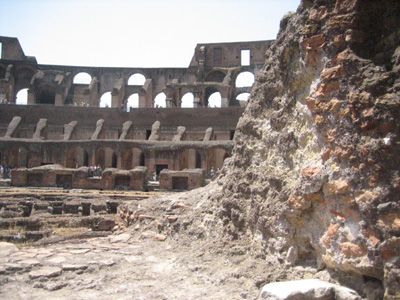 The Flavian Amphitheater began to be called the Colosseum when the Colossus of Nero statue was moved outside the grounds of the amphitheater. To organize the 50,000 people who packed into the Colosseum everyone in the city was given a section to sit in based on where they lived in the city. Each section had to enter through a specific gate in the Colosseum so everything ran smoothly. With everyone entering separate gates the crowd didn't seem nearly as big. The upper-class and the emperor sat on the lower-level, the lower-class say in the middle section, and freed slaves and women sat in the upper-level.
The Flavian Amphitheater began to be called the Colosseum when the Colossus of Nero statue was moved outside the grounds of the amphitheater. To organize the 50,000 people who packed into the Colosseum everyone in the city was given a section to sit in based on where they lived in the city. Each section had to enter through a specific gate in the Colosseum so everything ran smoothly. With everyone entering separate gates the crowd didn't seem nearly as big. The upper-class and the emperor sat on the lower-level, the lower-class say in the middle section, and freed slaves and women sat in the upper-level.
In 217 the Colosseum was struck by lightning that caused a major fire. The fire totally destroyed the upper levels of the amphitheater, which had been constructed entirely of wood. The upper levels weren't fully repaired until 240. This was also a time when the Roman Empire was beginning to show signs of weakening. Between the years of 235 and 284 there had been somewhere between 20 and 25 different emperors. The Emperor Diocletian slowed down the decline of Rome when he defeated the Germanic tribes who had attempted to cross the Danube and Rhine rivers and he also sent back the Sassanid invasions of Syria and Palestine. Diocletian also split the Roman Empire into two taking the Eastern Roman Empire centered on Byzantium for himself. The Colosseum now had very little relevance as there would be two capitals of the Roman Empire, but neither would be the city of Rome. The Western Roman Empire chose a new capital in the city of Mediolanum, which is modern-day Milan. The last recorded gladiator competition in the Colosseum was in 435 AD, although animal hunts were known to continue until 523 AD. This period was also the time when the Western Roman Empire fell after Emperor Romulus Augustus was deposed on September 4th, 476 by the Germanic barbarian Odovacar who became the first barbarian King of Italy. The Colosseum would soon be going through as many changes as the Roman Empire.
Emperor Diocletian's tetrarchy system of government was showing signs of weakness in the early 4th century. In 305 Diocletian and the Western Roman Emperor, Maximian, both abdicated their thrones, simultaneously becoming the first Roman Emperors to do so. Constantius took the throne in the West and was eventually succeeded by his son Constantine, who would finally end the persecution of Christians in the Roman Empire. Debate continues on when Constantine himself became a Christian as he wasn't actually baptized until his death, but many believe his love of Christianity from his Christian mother. After a civil war in the Western Roman Empire Constantine established his empire as a center for Christianity. However, Emperor Licinius of the Eastern Roman Empire and many of the people in the east held on to paganism and it was not long before a religious war developed between the two halves of the empire. In 325 Constantine defeated Licinius to once again unite the Roman Empire. The city of Byzantium was rebuilt and renamed New Rome and Constantine filled the city with Christian relics such as the True Cross and Rod of Moses and the figures of the old gods began to be replaced by Christian symbols. After Constantine's death in 337 his body was buried in the Church of the Holy Apostles in his new capital and the city was renamed Constantinople in his honor. This would mark major changes for the Roman Empire, the Colosseum, and the world as a whole.
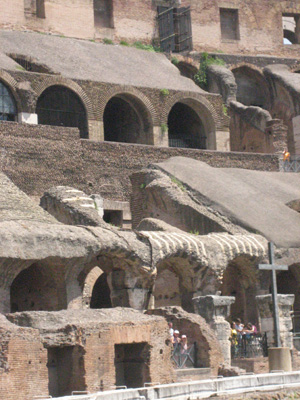 Late in the 6th century, after the arena had held its final contests, a small church was built in the amphitheater of the Colosseum while the arena floor itself was used for a cemetery. The numerous passageways under the arches of the Colosseum were used for low-rent housing and workshops and records indicate the Colosseum was still being rented out in the 12th century. In the year 1200 the Frangipani family bought the Colosseum to use it as a fortress. The family used a series of tunnels to connect their palace to the Colosseum so they could escape there easily in the event of an attack on their home. In 1349 a great earthquake hit the city of Rome and the Colosseum was severely damaged. The entire outer wall of the south side collapsed to give the structure the half-completed look it has today. Much of the stone recovered from the collapse was used to build palaces, churches, and other buildings. The bronze clamps that held much of the stone together were pillaged leaving the Colosseum looking much less grand with thousands of holes where the bronze used to be. In the mid-1500s Cardinal Farnese was given permission by his uncle, Pope Paul III, to take as much stone from the Colosseum as he could in 12 hours. The Cardinal gathered a force of 4000 men to do so and pillaged everything he could from the once grand amphitheater. Sometime during the 17th century, however, people began to leave the Colosseum alone through an unwritten sense of history, thus preserving one of the most important monuments of ancient Rome.
Late in the 6th century, after the arena had held its final contests, a small church was built in the amphitheater of the Colosseum while the arena floor itself was used for a cemetery. The numerous passageways under the arches of the Colosseum were used for low-rent housing and workshops and records indicate the Colosseum was still being rented out in the 12th century. In the year 1200 the Frangipani family bought the Colosseum to use it as a fortress. The family used a series of tunnels to connect their palace to the Colosseum so they could escape there easily in the event of an attack on their home. In 1349 a great earthquake hit the city of Rome and the Colosseum was severely damaged. The entire outer wall of the south side collapsed to give the structure the half-completed look it has today. Much of the stone recovered from the collapse was used to build palaces, churches, and other buildings. The bronze clamps that held much of the stone together were pillaged leaving the Colosseum looking much less grand with thousands of holes where the bronze used to be. In the mid-1500s Cardinal Farnese was given permission by his uncle, Pope Paul III, to take as much stone from the Colosseum as he could in 12 hours. The Cardinal gathered a force of 4000 men to do so and pillaged everything he could from the once grand amphitheater. Sometime during the 17th century, however, people began to leave the Colosseum alone through an unwritten sense of history, thus preserving one of the most important monuments of ancient Rome.
In the late 1500s Pope Sixtus V was trying to find a use for the ancient Colosseum. He thought he could solve two problems at once by turning the arena into a wool factory where the cities prostitutes could work, but this idea fell through after his unexpected death in 1590. In 1671 Cardinal Altieri decided the Colosseum would be a great place to hold bullfights, but public outcry shot down his idea. Finally, in 1749, Pope Benedict XIV put forth an official church policy that made the Colosseum holy ground on the basis that hundreds of early Christians were martyred there. This was a thinking first put forth by Pope St. Pius in the mid-1500s, but future Popes had not followed in St. Pius' path. Pope Benedict officially ended the pillaging of the Colosseum's stone and he began using the Colosseum for the Stations of the Cross, which are still held at the Colosseum every Good Friday. Future Popes would begin restoring the Colosseum and it was reinforced with brick wedges in 1807 and 1827 and in the 1930s. The arena's hypogeum was partially excavated in 1814 and 1874, and it was fully excavated in the 1930s by Mussolini.
Today the Colosseum is arguably the most popular tourist attraction in Rome. A major restoration project between 1993 and 2000 brought a new shine to the ancient structure and dramatically alleviated the damage caused by pollution. Most recently it has become a symbol of the campaign against capital punishment, which was abolished in Italy in 1948. A number of anti-death penalty demonstrations took place outside the Colosseum in 2000 and since then the Colosseum is lit in gold and white light whenever a death penalty is commuted anywhere in the world. While the Colosseum can no longer be used for large events because of the state of the interior it has been used as the backdrop for a number of major concerts. Ray Charles played at the Colosseum in 2002, Paul McCartney played there in 2003, and Elton John in 2005. In addition the Colosseum was designated one of the New Seven Wonders of the World in July of 2007 by the New Open World Corporation.